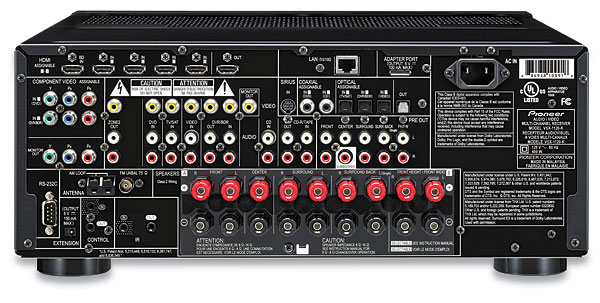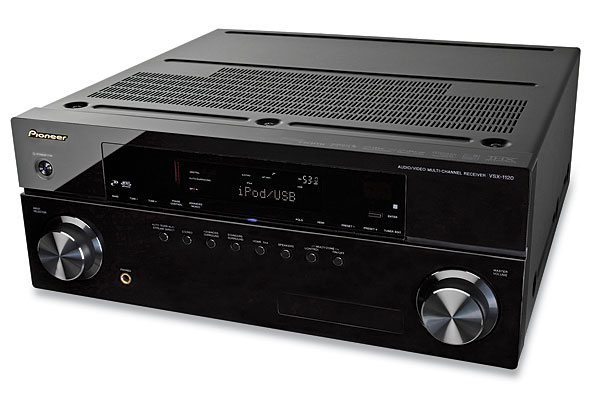I am in need of good top of the line AVR for my Home Theater....due to I needs an upgrade to HDMI's. My budgets is 500/600 US dollars....is any one can help me which one to choose from Pioneer VSX-1120-K or VSX-1021K OR any other good products/Brands in 500-600 price range....Thank you in advance Chetan
Pioneer VSX-1120 A/V Receiver Page 2

Associated equipment included five Paradigm Reference Studio 20 v.4 speakers and an OPPO BDP-83SE universal disc player. All movies were on Blu-ray Disc.
Minimal Tweaking
Having done a lot of listening-mode comparisons in my Elite SC-37 review, I decided to approach this one more simply, the better to meditate on the sound of this particular AVR. For movies and multichannel soundtracks in general, that meant using the Auto Surround mode, which detects the surround codec, adding MCACC, Phase Control (switchable), and bass management. I did not use the THX (Cinema, Music, Games), Auto Level Control (ALC), Direct, or Pure Direct modes for multichannel content; this AVR doesn’t have the Elites’ Optimum Surround mode feature.
The Fourth Kind, with DTS-HD Master Audio soundtrack, mixes dramatized footage with supposedly real (but actually faked) footage as it tells the story of a psychologist tussling with alien abductions in Alaska. The amount and amplitude of screaming rises as the movie goes on. Of more concern to me was the dialogue. Hushed reminiscences of alien encounters are often sotto voce, to the point where I was having a hard time catching some of it. The main menu’s MCACC Data Check led me to the problem: The center channel was set about a decibel lower than the front left and right. That might
be the right setting for some rooms and systems, but not for mine. I haven’t had this problem with previous MCACC A/V receivers, so it may have been a setup fluke—perhaps a bit of ambient noise during the calibration process. I often tweak bass with room-corrected products, usually with the sub’s volume control, but it wasn’t necessary in this case. Bass weight was perfect, with good pitch fidelity and no grossly obvious bloat.
Unthinkable, also in DTS-HD Master Audio, puts Samuel L. Jackson’s intensity to good use in a plot that raises troubling questions about terrorism and torture. As in the previous movie, the dialogue veered between screaming and soft-voiced menace. In both cases, I cruised along between the volume display’s decibel range from –17 to –20 (on a scale from –81 to +12, with 0 as the typically too-loud reference level). I watched all the movies with THX Loudness Plus on. While it allowed me to fuss less than I would with an AVR that lacks a low-volume listening mode, minor master volume changes were still necessary from time to time. (While THX Loudness Plus works well, I like Audyssey’s Dynamic EQ/Volume better for the latter’s three settings.)

Nick & Norah’s Infinite Playlist, in Dolby TrueHD, is a charming if slightly foulmouthed love story about a nerdy (by Hollywood standards) but genuinely charming couple who hurtle through Lower Manhattan’s music scene by night with their goofy friends. The consistently trebly mix served the music poorly, although it did make the dialogue clear in a TV-like fashion. The AVR made the best of an iffy situation, maintaining consistent clarity at a volume low enough for me to stand. Any movie scored by Mark Mothersbaugh of Devo can’t be all bad.
SACD Purist
This A/V receiver is one of two in its line that accepts a direct DSD signal from an SACD player for internal multichannel conversion to PCM instead of requiring the disc player to convert it. To be honest, as I switched the OPPO back and forth between DSD and PCM output, I couldn’t tell the difference—but the AVR did, with its front display reading “SACD” or “PCM” depending on the signal. This seemed like a good time to throw a couple of SACD/CD hybrid discs into the mix, with thanks to the small labels that continue to send me a stream of review copies.
Chesky is one of them. The Cuban singer Xiomara Laugart gets the fully Chesky treatment in La Voz: strong imaging in the left and right channels, no activity in the center, and just a hint of surround for extra spaciousness. While this approach is closer to surround-enhanced stereo than 5.1, there’s no denying that it suits Xiomara’s rich mezzo-soprano, partnered with bass, piano, sax, and canu (a Turkish autoharp)—most often one accompanist at a time. The Pure Direct mode proved the best vehicle for the contemplation of these beautifully filled 4.0 channels. The Paradigms had enough low-frequency response to fill out the string bass.
The Circle of Robert Schumann is another SACD, actually a two-disc set. Violinist Gudrun Schaumann and pianist Christoph Hammer explore works by Schumann, his beloved wife Clara, and others. In this recording, the center was active and the surrounds filled with rich reverb. Once again, I preferred Pure Direct mode. It may not have been as customized as the settings that used MCACC and Phase Control—but adding those forms of processing seemed to reduce the music to something cut and dried. Pure Direct allowed more of the room in the recording to be heard, in effect putting the chamber back in chamber music. In either mode, the recording showed an interesting approach to the centuries-old instruments used: The historically correct fortepiano was notably more distant from the microphone (or more distantly miked) than the Stradivarius, which reduced the inherent clatter of the keyboard instrument.
The untitled CD by the Wretched Refuse String Band was my only two-channel demo material. For this, I compared basic Dolby Pro Logic II (with 5.1 channels), the THX-enhanced DPLII, the Stereo mode with room correction and other enhancements, and Pure Direct. The latter flunked this time. It lost focus and blurred the many bluegrass musicians enthusiastically jamming the soundstage. Processed stereo was better, but DPLII (with or without THX) did the job still better, bringing in not only the room and phase corrections but also deriving a center channel. The album remains a delight, with its rewritten version of “Nothing” (RIP, Tuli Kupferberg) and two versions of “Thumbelina,” both with vertigo-inducing mandolin solos by Andy Statman.
Don’t let the Pioneer VSX1120’s value-line provenance fool you. This is a formidable product. Pioneer’s auto setup and room EQ, though proprietary, are now up there with the best licensed versions as far as my ears are concerned. THX Select2 Plus certification helps, with THX Loudness Plus being a particular, um, plus. At two and a half C-notes below $1,000, with further discounts all but certain from the usual online retailers, this A/V receiver is good enough to take your breath away.

- Log in or register to post comments































































